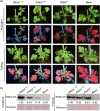The Naturally Occurring Amino Acid Substitution in the VPg α1-α2 Loop Breaks eIF4E-Mediated Resistance to PRSV by Enabling VPg to Re-Hijack Another eIF4E Isoform eIF(iso)4E in Watermelon
- PMID: 39587435
- PMCID: PMC11588673
- DOI: 10.1111/mpp.70033
The Naturally Occurring Amino Acid Substitution in the VPg α1-α2 Loop Breaks eIF4E-Mediated Resistance to PRSV by Enabling VPg to Re-Hijack Another eIF4E Isoform eIF(iso)4E in Watermelon
Abstract
Plant resistance, which acts as a selective pressure that affects viral population fitness, leads to the emergence of resistance-breaking virus strains. Most recessive resistance to potyviruses is related to the mutation of eukaryotic translation initiation factor 4E (eIF4E) or its isoforms that break their interactions with the viral genome-linked protein (VPg). In this study, we found that the VPg α1-α2 loop, which is essential for binding eIF4E, is the most variable domain of papaya ringspot virus (PRSV) VPg. PRSV VPg with the naturally occurring amino acid substitution of K105Q or E108G in the α1-α2 loop fails to interact with watermelon (Citrullus lanatus) eIF4E but interacts with watermelon eIF(iso)4E instead. Moreover, PRSV carrying these mutations can break the eIF4E-mediated resistance to PRSV in watermelon accession PI 244019. We further revealed that watermelon eIF(iso)4E with the amino acid substitutions of DNQS to GAAA in the cap-binding pocket could not interact with PRSV VPg with natural amino acid substitution of K105Q or E108G. Therefore, our finding provides a precise target for engineering watermelon germplasm resistant to resistance-breaking PRSV isolates.
Keywords: PRSV‐W; VPg; eIF(iso)4E; eIF4E; resistance breaking.
© 2024 The Author(s). Molecular Plant Pathology published by British Society for Plant Pathology and John Wiley & Sons Ltd.
Conflict of interest statement
The authors declare no conflicts of interest.
Figures






Similar articles
-
Variability in eukaryotic initiation factor iso4E in Brassica rapa influences interactions with the viral protein linked to the genome of Turnip mosaic virus.Sci Rep. 2018 Sep 11;8(1):13588. doi: 10.1038/s41598-018-31739-1. Sci Rep. 2018. PMID: 30206242 Free PMC article.
-
A natural substitution of a conserved amino acid in eIF4E confers resistance against multiple potyviruses.Mol Plant Pathol. 2024 Jan;25(1):e13418. doi: 10.1111/mpp.13418. Mol Plant Pathol. 2024. PMID: 38279849 Free PMC article.
-
Helper component proteinase of the genus Potyvirus is an interaction partner of translation initiation factors eIF(iso)4E and eIF4E and contains a 4E binding motif.J Virol. 2011 Jul;85(13):6784-94. doi: 10.1128/JVI.00485-11. Epub 2011 Apr 27. J Virol. 2011. PMID: 21525344 Free PMC article.
-
Genetic diversity in the 3'-terminal region of papaya ringspot virus (PRSV-W) isolates from watermelon in Oklahoma.Arch Virol. 2012 Mar;157(3):405-12. doi: 10.1007/s00705-011-1184-8. Epub 2011 Dec 9. Arch Virol. 2012. PMID: 22160129 Review.
-
The Molecular Maze of Potyviral and Host Protein Interactions.Annu Rev Virol. 2024 Sep;11(1):147-170. doi: 10.1146/annurev-virology-100422-034124. Epub 2024 Aug 30. Annu Rev Virol. 2024. PMID: 38848589 Review.
Cited by
-
Oligomeric SWEET1g of Solanum tuberosum confers resistance to potato virus Y and Potato virus X.Plant J. 2025 Aug;123(3):e70400. doi: 10.1111/tpj.70400. Plant J. 2025. PMID: 40758984 Free PMC article.
References
-
- Acosta‐Leal, R. , and Xiong Z.. 2008. “Complementary Functions of Two Recessive R‐Genes Determine Resistance Durability of Tobacco ‘Virgin A Mutant’ (VAM) to Potato virus Y .” Virology 379: 275–283. - PubMed
-
- Ayme, V. , Petit‐Pierre J., Souche S., Palloix A., and Moury B.. 2007. “Molecular Dissection of the Potato virus Y VPg Virulence Factor Reveals Complex Adaptations to the pvr2 Resistance Allelic Series in Pepper.” Journal of General Virology 88: 1594–1601. - PubMed
-
- Ayme, V. , Souche S., Caranta C., et al. 2006. “Different Mutations in the Genome‐Linked Protein VPg of Potato virus Y Confer Virulence on the pvr2 3 Resistance in Pepper.” Molecular Plant–Microbe Interactions 19: 557–563. - PubMed
-
- Borgstrøm, B. , and Johansen I. E.. 2001. “Mutations in Pea Seedborne Mosaic Virus Genome‐Linked Protein VPg Alter Pathotype‐Specific Virulence in Pisum sativum .” Molecular Plant–Microbe Interactions 14: 707–714. - PubMed
MeSH terms
Substances
Supplementary concepts
Grants and funding
- 2022KJ241/the Youth Innovation Team Plan for Shandong High Education Institution
- CXGC2024A05/Innovation Project of Shandong Academy of Agricultural Sciences
- CXGC2024B11/Innovation Project of Shandong Academy of Agricultural Sciences
- TS2022-028/the Taishan Scholar Project
- 31801704/National Natural Science Foundation of China
LinkOut - more resources
Full Text Sources
Research Materials
Miscellaneous

